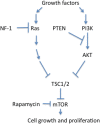Molecular pathogenesis of pancreatic neuroendocrine tumors
- PMID: 24281208
- PMCID: PMC3840460
- DOI: 10.3390/cancers2041901
Molecular pathogenesis of pancreatic neuroendocrine tumors
Abstract
Pancreatic neuroendocrine tumors (PNETs) are rare primary neoplasms of the pancreas and arise sporadically or in the context of genetically determined syndromes. Depending on hormone production and sensing, PNETs clinically manifest due to a hormone-related syndrome (functional PNET) or by symptoms related to tumor bulk effects (non-functional PNET). So far, radical surgical excision is the only therapy to cure the disease. Development of tailored non-surgical approaches has been impeded by the lack of experimental laboratory models and there is, therefore, a limited understanding of the complex cellular and molecular biology of this heterogeneous group of neoplasm. This review aims to summarize current knowledge of tumorigenesis of familial and sporadic PNETs on a cellular and molecular level. Open questions in the field of PNET research are discussed with specific emphasis on the relevance of disease management.
Figures
Similar articles
-
Molecular alterations in sporadic pancreatic neuroendocrine microadenomas.Pancreatology. 2016 May-Jun;16(3):411-5. doi: 10.1016/j.pan.2016.01.011. Epub 2016 Feb 9. Pancreatology. 2016. PMID: 26905832
-
Endoscopic Ultrasound Features of Multiple Endocrine Neoplasia Type 1-Related versus Sporadic Pancreatic Neuroendocrine Tumors: A Single-Center Retrospective Study.Digestion. 2018;98(2):112-118. doi: 10.1159/000487939. Epub 2018 Apr 26. Digestion. 2018. PMID: 29698969
-
Pancreatic Neuroendocrine Tumors: an Update.Indian J Surg. 2015 Oct;77(5):395-402. doi: 10.1007/s12262-015-1360-2. Epub 2015 Oct 13. Indian J Surg. 2015. PMID: 26722203 Free PMC article.
-
Update on pancreatic neuroendocrine tumors.Gland Surg. 2014 Nov;3(4):258-75. doi: 10.3978/j.issn.2227-684X.2014.06.03. Gland Surg. 2014. PMID: 25493258 Free PMC article. Review.
-
Surgical Management of Neuroendocrine Tumours of the Pancreas.J Clin Med. 2020 Sep 16;9(9):2993. doi: 10.3390/jcm9092993. J Clin Med. 2020. PMID: 32947997 Free PMC article. Review.
Cited by
-
Differences between Well-Differentiated Neuroendocrine Tumors and Ductal Adenocarcinomas of the Pancreas Assessed by Multi-Omics Profiling.Int J Mol Sci. 2020 Jun 23;21(12):4470. doi: 10.3390/ijms21124470. Int J Mol Sci. 2020. PMID: 32586046 Free PMC article.
-
MEN1/Menin regulates milk protein synthesis through mTOR signaling in mammary epithelial cells.Sci Rep. 2017 Jul 14;7(1):5479. doi: 10.1038/s41598-017-06054-w. Sci Rep. 2017. PMID: 28710500 Free PMC article.
References
LinkOut - more resources
Full Text Sources



